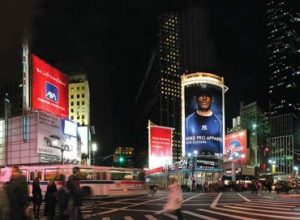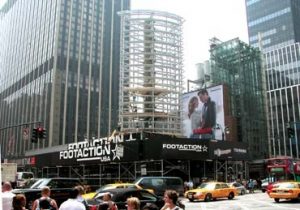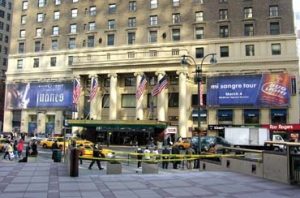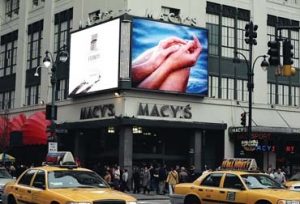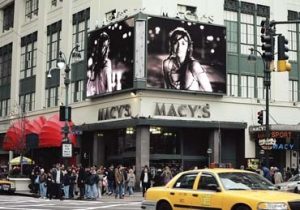Design
Signs of Success
Taking cue from Times Square, New York City’s Penn Plaza signage goes uptown
Published
18 years agoon
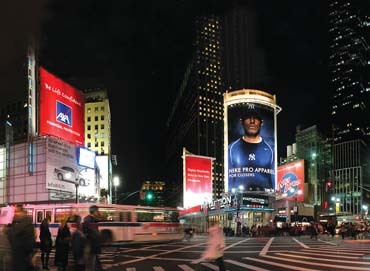
Signage enlivens an area. It attracts pedestrians and shoppers. It’s good for visitors, residents and, certainly, property owners, from whose buildings sign leases are created. With all the illuminated advertising that’s made visible through high-profile signage, it adds an effective celebratory element to an area that neighborhoods without signage can never match.”
— George Stonbely,
chairman of Clear Channel
Spectacolor (New York City)
Clear Channel Spectacolor has designed and placed more than half the spectaculars in Times Square. Drawing upon that expertise, the company is bringing the same success to Penn Plaza, another highly trafficked, Manhattan business district.
Whereas Times Square may be known as the “Crossroads of the World,” Penn Plaza is known as the “Crossroads of New York City.” Located in midtown Manhattan, Penn Plaza is bordered from W. 31st to W. 34th streets, and from Broadway to 8th Ave.
The area’s three major anchors are: Penn Central Station, where Amtrak, New Jersey Transit, Long Island Railroad and New York City’s subway system converge; Madison Square Garden, the noted sports and entertainment venue; and Macy’s Herald Square, the world’s largest department store (each of its nine floors measures a city block). Dozens of other retail stores and restaurants also comprise the Penn Plaza business district.
Annually, more than 10 million vehicles pass the intersection of 34th St. and 7th Ave. In 2002, an estimated 185.4 million commuters passed through Penn Central Station. Approximately 5,000 to 7,000 people walk through the area hourly. Aware of its impressive demographics, Penn Plaza and the local business community see that new, distinct signage will brighten the area.
Several Penn Plaza organizations and the 34th Street Partnership Business Improvement District have worked to elevate the business district’s signage to enhance the area’s image. Norman Mintz, design director for the 34th Street Partnership, noted that this sign strategy serves as a neighborhood-beautification incentive. Seen as iconic graphic elements, signs visually represent the neighborhood and businesses, and also integrate into an extended-neighborhood wayfinding system.
To enhance Penn Plaza’s local billboard development and outdoor-advertising landscape, Clear Channel Spectacolor, an advertising and spectacular-development company, partnered with Vornado Realty, the real-estate developer who owns Madison Square Garden, the Hotel Pennsylvania and 1 Penn Plaza, 2 Penn Plaza and other area properties.
“The Penn Plaza signage infusion isn’t intended to duplicate the glitz and density of Times Square,” said Mike McGraw, Spectacolor’s vice president of spectacular development. Instead, he said it will develop its own sign personality.
“Different sign formats that already appear in Times Square [vinyl, three-sided signage, electronic LED boards, spectaculars and dimensional signage] can also be installed in Penn Plaza,” McGraw said. “Which is to say, creatively speaking, anything goes.”
McGraw explained that area signcodes restrict only how high signs can be placed on a building and the quantity installed per building. He said that fewer signs installed per building in Penn Plaza will ease visual congestion.
“New signage in Penn Plaza is mostly dictated by the developers and their progress in modernizing other current buildings and adding new sign structures on those buildings whenever possible.”
A sign garden
This “first generation” of new signage promises a rosy future. Madison Square Garden (MSG), which serves as the area’s primary anchor tenant, is fronted by an out-of-date, incandescent, wedge-based marquee. An LED, full-motion display reportedly will eventually become the new beacon that announces MSG’s nightly events.
Directly opposite MSG’s 7th Ave. entrance, at the Hotel Pennsylvania, two, vinyl, mesh sheets hang between a cable-and-frame system across the first-floor, front windows. The window mesh provides a surface for printed advertisements, but also allows daylight to enter the hotel lobby. Each 18 x 57-ft. mesh panel is illuminated by six, 250W, quartz fixtures.
Moving north towards W. 33rd St., within a block of the hotel, two, identical, stainless-steel sign towers sit on the roof of the one-story Foot Action building. Installed on each building corner that faces 7th Ave., each wedge-shaped tower comprises a 74 x 39-ft. north face, 69 x 19-ft. west face and 69 x 37-ft. south face, which are backed by MDO and comprise front-lit vinyl.
Placed at the bottom of the sign structure, a series of 10, 1,000W, metal-halide fixtures illuminate each tower sign. Both sign towers, which are identical in shape and size, are oriented so that pedestrians can simultaneously see the curved front of one sign and, directly behind it, at a slightly skewed angle, the back of another sign.
North Shore Neon (Long Island, NY) installed the sign-tower structures. North Shore’s president, Tom Brown, said, although the signs appear on the building roof, they are actually independent of the building, having been mounted on freestanding, structural supports.
Each sign face, which measures approximately 2,250 sq. ft., generates a significant wind load that pushes against the building. To stabilize the sign (windy days in New York City are nothing to sniff at), the sign towers were anchored to bedrock, not the roof.
To accomplish this, vertical, steel supports were inserted in segments through the roof, the storefront floor, the Penn Central Station concourse area and two, underground floors of the metropolitan subway’s mezzanine, until they encountered bedrock. The triangle-shaped sign-tower structure, which has a three-column support, required six holes per floor.
After the support columns were placed, they were braced by tying them together at the top of the columns. This also allowed the sign tower to be properly mounted on the columns and bolted to their support structures.
The sign tower’s triangular shape also proved to be a challenge, said Dr. Ahmed Shabaan, PE, who engineered the sign-tower structure. “The shape of the sign tower looked, and acted like, an airplane wing,” Dr. Shabaan said.
Advanced, wind-analysis, computer modeling ensured the sign could withstand the wind loads. The sign-tower structure was designed to withstand at least 100-mph winds.
To give the sign tower the necessary rigidity, it was mounted on the support columns and anchored by a central, vertical pole. From the pole, horizontal arms extend, like three branches, to connect each of the three faces to the central pole. The branching format was repeated every 8 ft. along the length of the entire sign’s vertical pole.
Infiniti and beyond
Directly across the street from the Foot Action building, three billboards sit atop the H & M building (H & M is a clothing retailer). The Infiniti board is wall-mounted over the front entrance. Next to it, facing 34th St., a 16 x 45-ft., MDO-braced, vinyl billboard is frontlit with a series of 1,000W, metal-halide fixtures.
Between the two, the Infiniti billboard is one of the few spectaculars currently installed in the Penn Plaza area. The “hybrid,” print/LED videoboard incorporates a 28 x 37-ft., front-lit, print billboard. A long-term, Infiniti lease guarantees continued, automotive promotions.
The board also incorporates a TriBar LED videoscreen, which is mounted on the righthand corner of the vinyl board. Connected to the Internet, the screen receives real-time, Weather Channel updates as part of an advertising campaign that features the new, all-wheel-drive Infiniti line.
On the northeast corner of 34th St. and 7th Ave. (where more than 10 million vehicles drive by each year), Macy’s — more precisely, the back of the department store — features a full-color, animated, LED screen. Manufactured by Dallas-based Billboard Video (formerly known as Multimedia), the screen was commissioned as a set of LED screens mounted, side by side, around the building’s corner. The 21 x 16-ft. screens boast a 25mm pitch and a 288 x 400-pixel native resolution.
Known as “Macy’s Vision,” the screens advertise the store’s national brand promotions and such inhouse, special events as its annual flower show, and Independence Day and Thanksgiving celebrations. The screens are also available for outside advertising.
Gene Lisiten, a senior account executive with xtronx (San Francisco), which specializes in selling outdoor advertising for electronic billboards, noted Macy’s Vision is uniquely positioned for what it does.
“Because the LED screen’s location is on the corner of the Macy’s building, it offers extremely good visibility and has become a perfect, POP sign for pedestrians and vehicles passing by. Because Macy’s Vision is a dual-corner board, it lets you display two, different, but connected, ads for the client at the same time.”
As an added sweetener, most of the Clear Channel Spectacolor Penn Plaza sign structures are built to handle the transformation from a flexible-face panel to a heavyweight spectacular.
Overall, signage in the Penn Plaza and surrounding neighborhood enhances the community’s informative and functional presence. As this transformation continues, signage in the Penn Plaza and the 34th St. business district will create an increasingly spectacular visual statement.

SPONSORED VIDEO
Introducing the Sign Industry Podcast
The Sign Industry Podcast is a platform for every sign person out there — from the old-timers who bent neon and hand-lettered boats to those venturing into new technologies — we want to get their stories out for everyone to hear. Come join us and listen to stories, learn tricks or techniques, and get insights of what’s to come. We are the world’s second oldest profession. The folks who started the world’s oldest profession needed a sign.
You may like

Orbus Celebrates Earth Day With Recycling Achievements

American Sign Museum Names New Executive Director

3 Things Print Pros Must Do to Build Stronger Relationships in the Interiors Market
Subscribe

Bulletins
Get the most important news and business ideas from Signs of the Times magazine's news bulletin.
Most Popular
-

 Tip Sheet1 week ago
Tip Sheet1 week agoAlways Brand Yourself and Wear Fewer Hats — Two of April’s Sign Tips
-

 Photo Gallery2 days ago
Photo Gallery2 days ago30 Snapshots of the 2024 ISA Sign Expo
-

 Ask Signs of the Times4 days ago
Ask Signs of the Times4 days agoWhy Are Signs from Canva so Overloaded and Similar?
-

 Real Deal2 weeks ago
Real Deal2 weeks agoA Woman Sign Company Owner Confronts a Sexist Wholesaler
-

 Benchmarks7 days ago
Benchmarks7 days ago6 Sports Venue Signs Deserving a Standing Ovation
-

 Women in Signs2 weeks ago
Women in Signs2 weeks ago2024 Women in Signs: Megan Bradley
-

 Photo Gallery1 week ago
Photo Gallery1 week ago21 Larry Albright Plasma Globes, Crackle Tubes and More
-

 Women in Signs1 week ago
Women in Signs1 week ago2024 Women in Signs: Ashley Borell
